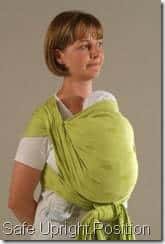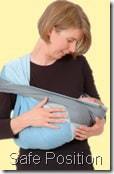My friend Hadassa Levy, a babywearing consultant, wrote this guest post in light of safety warnings connected to soft baby carriers.
Israeli parents and caregivers are concerned and confused about babywearing, after a US consumer advisory warned that wearing your baby in a sling can lead to suffocation. The warning followed a number of infant deaths in 2009. Could it be that baby slings are dangerous for our little ones? Should we reconsider our pro-babywearing attitude in light of those tragic incidents?
Babywearing has been practiced throughout the centuries in all cultures and is still the most common method of transporting babies in many countries. A baby’s anatomy and psyche is designed for babywearing: When picked up, newborns immediately cling to their parents’ body and calm instantly when nestled close to the heart and reassuring warmth of their mothers. For parents of high-need or colicky babies, the sling can be a lifesaver. Babywearing improves the bond between parent and child, and promotes the baby’s physical and sensual development. Babywearing is practical when it comes to public transportation, hiking, shopping or caring for several small children at the same time.
But with countless types and brands of baby carriers available on the market, parents and caregivers should be aware of essential safety rules.
 The tragic infant deaths in the US were caused by improper positioning in bag-type slings, where the baby is kept in a curled cradle position bending the chin toward the chest. This position restricts the airway and slowly suffocates the baby. (See image on left.) Although that specific type of carrier is not available in Israel, the cradle position is widely used. I’m seeing a lot of curled-up babies, especially with the most common stretchy wrap material that makes proper positioning difficult.
The tragic infant deaths in the US were caused by improper positioning in bag-type slings, where the baby is kept in a curled cradle position bending the chin toward the chest. This position restricts the airway and slowly suffocates the baby. (See image on left.) Although that specific type of carrier is not available in Israel, the cradle position is widely used. I’m seeing a lot of curled-up babies, especially with the most common stretchy wrap material that makes proper positioning difficult.
Therefore, I generally recommend upright tummy-to-tummy holds for newborns in a properly tightened baby wrap or ring sling. (Photo at left below) The upright position is a safer choice for several reasons: Baby’s neck is in a straight line with the body and his face rests on the  wearer’s chest, with free airflow on both sides. When the wrap is tightened properly, the immature rounded spine gets maximum support and the natural “frog-leg”-position promotes the development of baby’s cartilaginous hip joints.
wearer’s chest, with free airflow on both sides. When the wrap is tightened properly, the immature rounded spine gets maximum support and the natural “frog-leg”-position promotes the development of baby’s cartilaginous hip joints.
If parents do choose the cradle hold, for discreet breastfeeding, for example, they should always make sure the baby is positioned in a nearly horizontal position across the parent’s chest with the neck in a straight line with the body and the face free. (See image on right.)
for example, they should always make sure the baby is positioned in a nearly horizontal position across the parent’s chest with the neck in a straight line with the body and the face free. (See image on right.)
The baby should be worn close to the parents body and high enough for the parent to easily kiss his face.
No matter which carrier or position is used, babywearers should always be alert to baby’s movements and reactions and check frequently that no material is draped over the face.
Prior to purchasing a baby carrier I advise every parent to consult with a babywearing professional, who will help find the ideal carrier for each familiy’s individual situation and offer thorough instructions on how to use the carrier properly. Salespeople in baby stores are not usually trained in babywearing, and the number of babywearing consultants in Israel is growing. Most sell carriers themselves, but will also be happy to assist with a carrier that the family already owns.
Resources and further reading:
Official statement from Babywearing International
Sleepywrap: Useful information on positioning, baby development and more
Correct positioning in different baby carriers
Baby’s anatomy and frog-leg position
Upright vs. Cradle (Hebrew)
About the author:
Hadassa Levy is a babywearing instructor offering private and group consultations as well as a wide range of baby carriers. Her Hebrew/English website website and blog contain information, instruction videos and answers to frequently asked questions about babywearing. She lives in Modiin with her husband and daughter.
If you enjoyed this post you may also enjoy:
Breastfeeding and the Working Mother
Breastfeeding Late Pre-Term Babies

This is a matter of commonsense, is it not? American product-safety warnings are entirely out of hand. They discourage people from otherwise salutary activities. Babywearing included. (A woman I did not know once saw me wearing my baby on my back and warned me that I was endangering my child’s life. I tried to tell her my kid was happier that way than in a stroller. But she didn’t get it.)
interesting post! have you heard of lenore skenazy? she talks a lot about americans especially being safety crazed because of the media and the way safety, crimes, product problems, etc are portrayed on say, the evening news. i really like the point that this author makes about how baby wearing has been practiced for centuries. the term “if it ain’t broke don’t fix it” comes to mind!
You might be interested in Babywearing International’s sling safety page: http://babywearinginternational.org/pages/InfantSlingSafety.php.
~ Maya
Hadassah, I carried around my oldest three in the cradle position – that was the only sling available at the time. It is upsetting to think that I may have been slowly suffocating them (although they are more or less OK today).
Many people told me (friends, family and strangers) that it wasn’t safe for the baby, but I glibly answered that of course it was. I feel bad about that.
With my next two kids I had three big kids in the house to help, so I didn;t do too much baby wearing. SOmeone gave me the long wrap aroung kind that you recommend for my 5th. However, he was born in June and it was sooo hot that I just could not wear him. I was truly concerned he would overheat.
Thank you for the interesting post,
Ariela
@ Ms. Krieger, common sense can be buried under layers of conflicting information, especially when new parents are told what to do to/for their babies. In the West in particular, I think babywearing is a lost art/practice and people really need instruction. Luckily I found it when my first baby was very young, and I was able to improve and pass it on to others.
@Ariela, I’d hate to think that this incident (and maybe even what I wrote) left a bad feeling with you regarding the way you carried your babies. With all the turmoil caused around the heartbreaking incidents in the States we must keep in mind that countless babies are carried today – in cradle and other positions – and are perfectly alright. However, as a babywearing instructor I have to explain the pros and cons of different carriers and positions including the potential difficulty of breathing in the cradle position in certain carriers.
@Kate: I agree with you. Similar to the art of breastfeeding, babywearing should receive more attention in terms of instruction and education, so that mothers can (re-)build trust and confidence in carrying their babies.
@ms. krieger / minnesota mamaleh: I also have a feeling that the States are a bit overdoing it with safety guidelines and warnings, but new moms are often insecure and can be easily confused with an official statement like that so it is important to keep explaining 🙂
Hi Hadassa,
Great post — I’d like to link to it on my blog if that’s ok. I just stared importing Wrapsody Baby gauze wraps and lightweight stretch wraps, which will answer the “overheating” issues as well as the safe back carry in a stretch wrap issues.
Melissa
No problem, Melissa. Thanks for the visit.
If you support safe babywearing, please consider becoming a friend, champion, or business member of the Baby Carrier Industry Alliance, babycarrierindustryalliance.org.